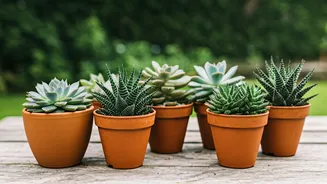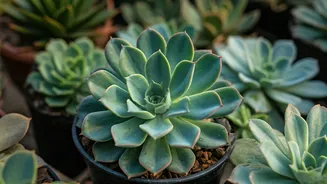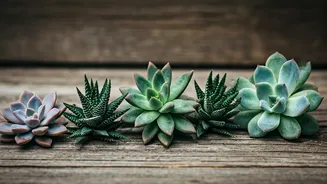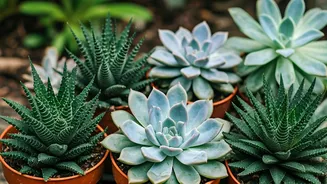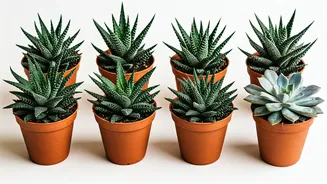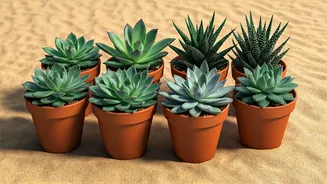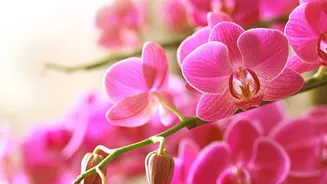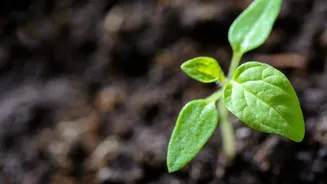Sempervivum (Hens and Chicks)
Sempervivum, often called Hens and Chicks, is a popular choice for its resilience and striking rosette formations. These succulents get their name from
their unique growth pattern: a larger 'hen' plant produces smaller 'chick' offsets. They're well-suited to various environments and can endure both drought and cold conditions, making them ideal for gardens in diverse climates. They thrive in well-draining soil and need ample sunlight. The variety in color, from deep greens to reds, adds visual interest to any space. Caring for Sempervivum involves minimal watering and occasional fertilization during the growing season. With proper care, they can form stunning clusters and thrive for many years, adding a touch of natural beauty and enduring charm to any garden or container display.
Agave: The Architectural Marvel
Agave plants are known for their striking architectural forms and impressive lifespan. These succulents, native to the Americas, can live for several decades, adding a dramatic presence to any landscape. They are characterized by their large, often spiky leaves that form a rosette. Agave plants prefer full sun and well-draining soil, thriving in warm, dry climates. While they are relatively low-maintenance, they require careful handling due to their sharp spines. The most distinctive feature of the Agave is their monocarpic nature, which means they flower only once at the end of their life, producing a tall flowering stalk. This dramatic event is followed by the plant's demise, but not before producing many offshoots, continuing the cycle of life. Their drought tolerance and ability to withstand neglect make them ideal for xeriscaping and adding a bold, sculptural element to gardens.
Aloe: Healing and Longevity
Aloe plants are not only valued for their medicinal properties but also for their longevity. Many Aloe species can live for several decades with proper care, providing a continuous source of soothing gel. Aloe plants are characterized by their fleshy, pointed leaves that radiate from a central stem. They thrive in warm climates and need well-draining soil and plenty of sunlight. Regular but infrequent watering is essential to prevent root rot. Aloe is relatively easy to propagate, producing offsets or 'pups' that can be transplanted. Their ability to purify air and offer various health benefits make them a popular choice for indoor and outdoor settings. With minimal effort, Aloe plants can be a long-lasting, beneficial addition to any home garden, blending beauty with functionality.
Echeveria: Colorful Rosettes
Echeveria succulents are celebrated for their vibrant, rosette-shaped foliage and their ability to thrive for many years. These plants come in a vast array of colors, from shades of green and blue to pink and red, providing a colorful display. They require well-draining soil and ample sunlight to develop their best coloration and form. Regular but infrequent watering is essential to avoid overwatering, which can lead to root rot. Echeverias are also quite adaptable and can be grown both indoors and outdoors in suitable climates. They propagate easily from leaves or offsets. These succulents offer an excellent choice for adding a touch of elegance and vivid color to rock gardens, containers, or indoor displays. Their enduring beauty makes them a favorite among succulent enthusiasts.
Sedum: Versatile and Tough
Sedum succulents are known for their versatility, robustness, and impressive longevity. These plants offer a wide variety of forms and sizes, from low-growing ground covers to taller, upright varieties. Sedums are easy to care for, thriving in full sun and well-draining soil. They are highly drought-tolerant, making them ideal for low-maintenance gardens and xeriscaping. Many Sedum varieties are cold-hardy, allowing them to thrive in various climates. They are easily propagated from cuttings, making it simple to expand your collection. Whether planted in rock gardens, containers, or used as ground cover, Sedums bring textural variety and lasting beauty. They also attract pollinators, making them a beneficial addition to any garden.
Crassula: The Jade Plant
Crassula, particularly the Jade Plant (Crassula ovata), is known for its remarkable longevity, often living for many decades, even centuries, with proper care. These succulents are characterized by their thick, fleshy leaves and tree-like appearance. Jade Plants thrive in bright, indirect light and well-draining soil, making them a popular choice for indoor cultivation. They tolerate infrequent watering, and it is crucial to allow the soil to dry out between waterings to prevent root rot. Jade Plants are also relatively easy to propagate, creating new plants from leaf cuttings or stem cuttings. With their robust nature and elegant appearance, Jade Plants can become cherished family heirlooms, providing beauty and a touch of enduring natural wonder to any home or garden setting. Their longevity makes them a timeless addition.
